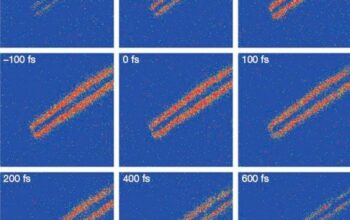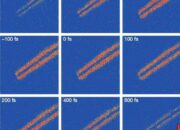The allure of carbon nanotubes (CNTs) lies not only in their unique structural comprehensibility but also in their multifactorial applications in modern science, particularly in energy storage and conversion technologies. These cylindrical nanostructures, akin to rolled sheets of graphene, possess extraordinary mechanical, thermal, and electrical properties, making them an invaluable asset in the pursuit of sustainable energy solutions. Among the various applications that carbon nanotubes present, the potential to store solar energy—encapsulated in the phrase “sunlight in a cylinder”—stands out as a groundbreaking concept.
Fundamentally, the structure of carbon nanotubes is pivotal to their functionality. Composed entirely of carbon atoms arranged in a hexagonal lattice, CNTs exhibit a high surface area-to-volume ratio, which is instrumental in energy absorption and storage processes. This structural anatomy not only facilitates superior electron mobility but also enables optimal photon capture, thus enhancing the efficiency of solar energy conversion. When elucidating the mechanics of how these nanostructures interact with light, one must consider the quantum confinement effects inherent within their geometry.
As sunlight hits the carbon nanotubes, the photo-excitation of electrons occurs, leading to the creation of excitons—quasi-particles that carry energy. This excitation can be remarkably efficient due to minimal electron-phonon scattering at the nanoscale, which is a common hindrance in bulk materials. The resultant excitons have the potential to either dissipate energy as heat or be harnessed for further energy storage processes. Understanding the dynamics of these excitons, particularly their lifetime and transport mechanism, is crucial for optimizing the use of carbon nanotubes in solar energy applications.
The integration of carbon nanotubes into solar cell technology has garnered significant attention, particularly regarding their use as a conductive medium in hybrid organic-inorganic photovoltaic systems. These advanced solar cells leverage the tunable electronic properties of CNTs to improve charge separation and transportation. By depositing carbon nanotubes onto photoactive layers, researchers have observed enhancements in light absorption and improved overall efficiency metrics. The ensuing synergies between organic materials and CNTs signify a leap towards procuring energy sustainability through innovative nanotechnology.
Moreover, the idea of integrating carbon nanotubes with energy storage systems, such as batteries and supercapacitors, accentuates their versatility. Their remarkable conductivity and high surface area allow for faster charge and discharge cycles, which is essential for efficient energy use. In the realm of solar energy, the coupling of CNTs with traditional storage mediums can facilitate the creation of systems that not only harness but also optimize the use of solar energy. This interoperability suggests a future where energy can be stored and utilized on demand, aligning perfectly with modern demands for renewable energy.
Carbon nanotubes also demonstrate prowess in thermal energy management, an area often overlooked in discussions surrounding solar energy technologies. Their exceptional thermal conductivity enables effective heat dissipation, which is crucial for maintaining the operational efficiency of solar cells. A significant challenge in solar energy systems is the degradation of materials under prolonged exposure to heat, leading to reductions in performance. The integration of carbon nanotubes as thermal management materials can prolong the lifespan of solar technologies, ensuring that they remain efficient over longer periods.
In exploring the fascination with carbon nanotubes in the context of solar energy storage, it is necessary to address some deeper implications. Their unique intersections with engineering, physics, and chemistry encapsulate a paradigm shift in materials science. Carbon nanotubes are not merely a fascinating phenomenon; they embody the confluence of natural and synthetic design principles. Researchers continuously seek to emulate nature’s ingenuity through the manipulation of nanoscale materials, reminiscent of biomimicry strategies in fields such as architecture and engineering.
Nevertheless, several challenges persist in the widespread application of carbon nanotubes in solar energy technologies. The synthesis of these materials remains a complex and often costly endeavor, with methods such as chemical vapor deposition (CVD) dominating the field. Establishing scalable and sustainable production techniques will be essential for the broader adoption of CNTs. Additionally, considerations surrounding environmental impact and toxicity must be rigorously evaluated. The potential leaching of nanotubes into ecosystems poses a significant concern that necessitates comprehensive studies before practical deployment.
Looking ahead, the landscape of solar energy storage is poised for transformation through advancements in carbon nanotube technology. Researchers are increasingly focused on hybrid systems that combine CNTs with other nanomaterials to create multifunctional platforms capable of harnessing and storing energy more efficiently. Innovations such as composite materials enhance the structural integrity and functionality of solar panels while leveraging the innate benefits of carbon nanotubes.
Ultimately, the synthesis of carbon nanotubes with solar energy technologies epitomizes a forward-thinking approach to energy sustainability. As society grapples with alarming climate change and dwindling fossil resources, exploring the depths of nanotechnology could herald an era characterized by clean, renewable energy solutions. It is not merely the material itself that holds fascination but the myriad possibilities it extends into a future rich with potential. In encapsulating sunlight within the cylinder of a carbon nanotube, a glimpse into a sustainable future becomes vivid—a future where energy is continuously harvested, managed, and utilized with unprecedented efficiency.










